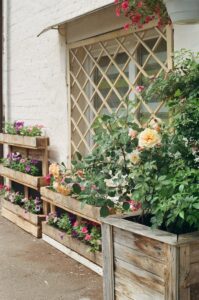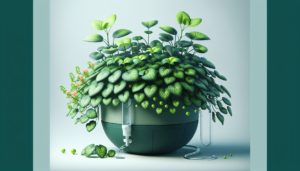Are you yearning for a tranquil oasis amidst the hustle and bustle of urban life? Look no further! Our captivating guide will show you how to create your own urban garden, transforming your outdoor space into a green sanctuary. From selecting the perfect plants that thrive in city environments to maximizing limited spaces with creative arrangements, we have all the tips and tricks you need to bring nature into your concrete jungle. So grab your gardening gloves and prepare to embark on a journey filled with lush greenery and vibrant blooms at your doorstep!
Choosing the Right Location for Your Urban Garden
When starting an urban garden, location is one of the most crucial factors to consider. Finding the ideal spot will ensure the success of your garden and maximize its potential. Here are some key considerations:
Sunlight Requirements
Plants need sunlight to thrive, so choosing a location that receives adequate sunlight throughout the day is crucial. Observe your outdoor space and identify areas with the most exposure to sunlight. Aim for at least six hours of direct sunlight per day for most vegetables and herbs.
Access to Water
Water is the lifeblood of any garden, so access to a reliable water source is essential. Look for a location within reach of a water hose or rainwater collection system. Additionally, consider the convenience of watering your plants without damaging your home or neighboring properties.
Soil Quality
Good quality soil is the foundation of a healthy garden. Assess the soil in your chosen location to determine its composition and fertility. Conduct a soil test to evaluate the pH level and nutrient content. If necessary, amend the soil by adding organic matter, such as compost or aged manure, to improve its structure and nutrient availability.
Size and Space Considerations
Consider the available space when choosing the location for your urban garden. Measure the area and determine how many plants you can comfortably accommodate. Remember that plants need proper spacing for optimal growth. Take into account each plant’s mature size and provide enough room for them to develop and spread their roots.
Deciding What to Grow in Your Urban Garden
The variety of plants you choose to grow in your urban garden will depend on your needs, preferences, and the specific conditions of your location. Here are some essential factors to consider:
Determine Your Needs and Preferences
Consider what you and your family enjoy eating the most. Do you want to grow vegetables, herbs, or even fruits? Additionally, think about any dietary restrictions or preferences you may have. By growing your produce, you can control the quality and freshness of your food.
Consider Local Climate and Seasonality
Consider your area’s climate and the specific seasons in which you plan to garden. Research which plants suit your region and identify their ideal planting and harvesting times. This knowledge will help you select plants well-adapted to your climate, increasing their chances of success.
Choose Plants Suitable for Container Gardening
Due to limited space, urban gardens often involve growing plants in containers. Select plants that thrive in containers and have compact growth habits. Vegetables like tomatoes, peppers, and lettuce are well-suited for container gardening. Herbs such as basil, mint, and rosemary are also excellent choices.
Mix and Match Different Plant Varieties
Don’t be afraid to mix and match different types of plants in your urban garden. Companion planting, the practice of growing other plants together for mutual benefit, can help improve plant health and increase crop yields. For example, planting marigolds among your vegetables can help deter pests, while growing beans near corn can enhance nitrogen levels in the soil.
Preparing the Soil for Your Urban Garden
Before you start planting, preparing the soil to provide the best growing conditions for your plants is essential. Follow these steps to ensure your soil is fertile and ready for planting:
Clearing the Area
Begin by clearing the chosen area of any debris, rocks, or weeds. This will create a clean canvas for your garden and help prevent competition and nutrient depletion.
Testing and Adjusting Soil pH
Testing the soil pH is essential to understand its acidity or alkalinity. Most plants prefer a pH range between 6 and 7, slightly acidic to neutral. If the pH level is not within the desired range, you can adjust it by adding soil amendments such as lime to increase pH or sulfur to decrease it.
Adding Organic Matter and Nutrients
Enriching the soil with organic matter is crucial for optimal plant growth. Add compost, well-rotted manure, or other organic materials to improve soil structure, water retention, and nutrient availability. Additionally, consider incorporating slow-release organic fertilizers to provide a steady supply of nutrients throughout the growing season.
Creating Drainage Systems
Good drainage is essential to prevent waterlogging and root rot. Ensure your garden has proper drainage by creating a gentle slope or raised beds to allow excess water to flow away. If you have heavy clay soil, you can incorporate organic matter or perlite to improve drainage and aeration.
Selecting Containers for Your Urban Garden
Container gardening is a popular choice for urban gardeners, as it allows for flexibility and mobility. When selecting containers for your urban garden, consider the following factors:
Determining the Size and Depth
The size and depth of your containers will depend on the plants you intend to grow. Large, deep containers are suitable for plants with extensive root systems, while smaller pots are ideal for herbs and lettuce. Ensure your containers provide enough room for the plants to grow and develop.
Choosing the Right Material
Containers come in various materials, each with its advantages and considerations. Clay or terracotta pots are aesthetically pleasing but may require more frequent watering. Plastic containers are lightweight and retain moisture better. Fabric pots provide excellent drainage and air circulation for plant roots. Consider the specific needs of your plants and choose containers accordingly.
Providing Adequate Drainage
Good drainage is crucial for the health of your plants. Ensure your containers have drainage holes at the bottom to allow excess water to escape. This will prevent waterlogged soil, which can lead to root rot. You can also place a layer of gravel or broken pottery shards at the bottom of the container to facilitate drainage.
Ensuring Mobility and Stability
Urban gardens often require flexibility, as you may need to move your plants around to optimize light exposure or protect them from extreme weather conditions. Choose containers that are lightweight and easy to maneuver. Additionally, ensure that your containers are stable and won’t topple over when subjected to strong winds.
Planting and Transplanting in Your Urban Garden
Planting and transplanting are exciting stages in your urban gardening journey. Follow these steps to ensure successful plant establishment:
Starting from Seeds
Refer to the seed packet instructions for planting depth and spacing requirements if starting your plants from seeds. Prepare small containers filled with seed-starting mix and sow the seeds according to the recommended guidelines. Provide the seeds with consistent moisture, warmth, and light until they germinate and develop into seedlings.
Transplanting Seedlings
After the seeds have germinated and developed into sturdy seedlings, it’s time to transplant them into their final containers or garden beds. Ensure the soil is moist before gently removing the seedlings from their containers. Dig a hole slightly larger than the root ball and place the seedling in, ensuring it is at the same level as in the previous container.
Spacing and Arrangement
Proper spacing is crucial to promote healthy growth and prevent overcrowding. Refer to the plant’s specific spacing requirements to determine the optimal distance between each plant. Consider the plant’s mature size and arrange them accordingly to prevent shading or competition for nutrients.
Caring for Young Plants
After transplanting, water the young plants thoroughly to settle the soil and ensure good root-to-soil contact. Keep the soil moist, but avoid overwatering, which can lead to root rot. Monitor your plants regularly for signs of pests or diseases, and take prompt action to address any issues.
Providing Water and Nutrients to Your Urban Garden
Water and nutrients are essential for the growth and development of your plants. Proper irrigation and fertilization techniques will ensure their health and productivity. Consider the following tips:
Understanding Watering Needs
Different plants have varying watering needs, so it’s essential to understand the requirements of each species. Generally, plants should be watered deeply and infrequently to encourage profound root growth. Avoid overhead watering, as it can promote fungal diseases. Instead, drip irrigation or watering at the soil level can deliver water directly to the roots.
Choosing the Right Irrigation Method
Various irrigation methods are available for urban gardening, each with pros and cons. Drip irrigation is efficient and minimizes water waste, while sprinkler systems provide even coverage but can be less water-conserving. Choose an irrigation system that suits your garden size, available resources, and water conservation goals.
Fertilizing Plants
Plants require nutrients to grow and thrive. Organic fertilizers, such as compost and well-rotted manure, are excellent choices for urban gardens. Apply fertilizers according to the specific needs of your plants and avoid overfertilization, as it can lead to nutrient imbalances and environmental pollution. Follow the instructions on the fertilizer package and adjust the dosage as needed.
Using Organic and Synthetic Nutrients
In addition to organic fertilizers, you may also consider supplementing your plants with synthetic nutrients. Synthetic fertilizers provide concentrated and readily available nutrients. However, they should be used sparingly and according to the manufacturer’s instructions, as excessive use can harm the environment and lead to nutrient imbalances in the soil.
Managing Pests and Diseases in Your Urban Garden
Pests and diseases can pose significant threats to the health and productivity of your urban garden. Here are some strategies to manage these common issues:
Identifying Common Urban Garden Pests
Learn to identify common pests that may afflict your plants, such as aphids, slugs, snails, and caterpillars. Regularly inspect your plants for signs of pest damage, including holes in leaves, chewed stems, or sticky residue. Early detection is critical to preventing infestations from spreading and causing irreparable damage.
Implementing Natural Pest Control Methods
Incorporating natural pest control methods in your gardening practices can help reduce pest populations and minimize the use of harsh chemicals. Encourage beneficial insects, such as ladybugs and lacewings, by planting nectar-rich flowers. Use physical barriers like nets or row covers to protect vulnerable plants. Additionally, handpicking pests or using organic insecticides can effectively deter unwanted visitors.
Using Organic and Chemical Pesticides
When natural pest control methods are insufficient, you may need to resort to organic or chemical pesticides. Organic pesticides, derived from natural sources, are a safer alternative to synthetic chemicals. However, they should be used judiciously and sparingly, as even organic pesticides can harm beneficial insects. Select pesticides that target the specific pests affecting your plants and follow the application instructions carefully.
Preventing and Treating Diseases
Prevention is critical to managing plant diseases. To minimize the risk of fungal infections, ensure proper air circulation and avoid overhead watering—practice crop rotation and adequate sanitation, such as cleaning garden tools and removing diseased plant debris. Identify the cause of diseases and choose appropriate treatments, such as organic fungicides or biological control agents.
Maintaining the Urban Garden
Proper maintenance is crucial to ensure your urban garden’s long-term health and productivity. Here are vital tasks to perform regularly:
Pruning and Trimming
Regular pruning and trimming help promote plant health and shape the growth of your plants. Remove dead or damaged branches, as well as any suckers or runners that may divert energy from the main plant. Prune accordingly to maintain the desired size and shape of your plants.
Weeding and Mulching
Weeding is an essential task to prevent competition between plants and unwanted growth. Remove weeds by hand or use mulch to suppress their growth and conserve soil moisture. Organic mulch, such as straw or wood chips, can prevent weed emergence and help regulate soil temperature.
Supporting Plants with Trellises and Stakes
Certain plants, such as tomatoes, cucumbers, and beans, require support to grow upright and maximize space. Install trellises, stakes, or cages to provide support and prevent sprawling. Regularly check the plant’s growth to ensure they are adequately secured and adjust the support structures.
Regular Monitoring and Maintenance
Regularly monitor your plants for stress, nutrient deficiencies, or pest and disease issues. Check the soil moisture, pH levels, and nutrient availability to ensure optimal growing conditions. Perform routine maintenance tasks, such as clearing debris and adjusting irrigation schedules. By staying diligent with garden maintenance, you can address issues promptly and provide a thriving garden.
Harvesting and Enjoying the Fruits of Your Urban Garden
The ultimate reward of urban gardening is harvesting and enjoying the delicious fruits of your labor. Here’s how to make the most of your harvest:
Knowing When to Harvest
Proper timing is crucial when harvesting your crops. Each plant has unique signs of maturity, such as a change in color, size, or texture. Refer to planting guides or consult gardening resources to determine the specific indicators for each crop. Harvesting at the right time ensures peak flavor and texture.
Harvesting Techniques for Different Crops
Different crops require specific harvesting techniques to ensure minimal damage and optimal taste. For leafy greens, harvest the outer leaves while leaving the central ones intact for continuous growth. Use sharp pruners or scissors to avoid damaging fruiting plants like tomatoes or peppers. Consult gardening resources for best practices for each crop you are growing.
Preserving and Storing Produce
If you have an abundance of produce, consider preserving or storing it for later use. Options include canning, freezing, drying, or fermenting your fruits and vegetables. Properly store your harvest in excellent, dry conditions to maximize shelf life. Utilize root cellars and refrigerators, or freeze your produce for longer-term preservation.
Sharing and Enjoying Your Harvest
Remember to share the bounty of your urban garden with friends, family, or neighbors. Sharing fosters community spirit and ensures that your harvest doesn’t go to waste. Enjoy your garden-fresh produce by incorporating it into delicious meals, sharing recipes, or hosting farm-to-table gatherings. The joy of growing your food is genuinely enhanced when shared with others.
Creating a Sustainable and Eco-Friendly Urban Garden
Incorporating sustainable practices into your urban garden benefits the environment and contributes to your plants’ overall health. Here are some eco-friendly strategies to consider:
Composting Organic Waste
Reduce waste and nourish your garden by composting organic matter. Create a compost bin or worm composting system to transform kitchen scraps, yard waste, and plant debris into nutrient-rich compost. Use the finished compost to enrich your soil, reduce the need for synthetic fertilizers, and promote healthy microbial activity.
Using Renewable Energy Sources
Explore the possibility of utilizing renewable energy sources to power your urban garden. Install solar panels or wind turbines to generate clean and sustainable energy. Use this energy to operate irrigation systems, lighting, or electric tools, reducing your dependence on fossil fuels.
Conserving Water and Reducing Waste
Efficient water management is crucial in urban gardening. Collect rainwater using barrels or cisterns and utilize it for irrigation. Install water-efficient drip or micro-irrigation systems to minimize water waste. Additionally, practice water-conserving techniques such as mulching, which helps retain soil moisture and reduce evaporation.
Encouraging Biodiversity
Promote biodiversity in your urban garden by planting diverse plants and incorporating habitat features. Include native plants that attract pollinators and beneficial insects, such as bees and butterflies. Provide nesting sites and shelter for birds and small animals. By creating a habitat that supports diverse wildlife, you enhance the resilience and balance of your garden ecosystem.
In conclusion, creating an urban garden is a rewarding and fulfilling endeavor. By carefully choosing the right location, selecting suitable plants, preparing the soil, choosing containers, and providing proper care, you can enjoy a flourishing garden right in the heart of the city. Embrace sustainable and eco-friendly practices further to enhance the health and productivity of your garden while contributing positively to the environment. So, roll up your sleeves, grab your gardening tools, and unlock the potential of your urban space – a green oasis awaits!



